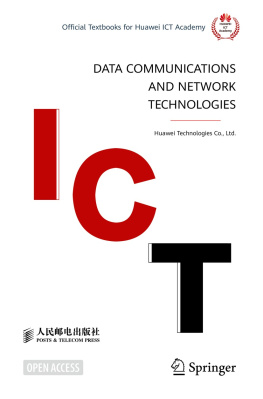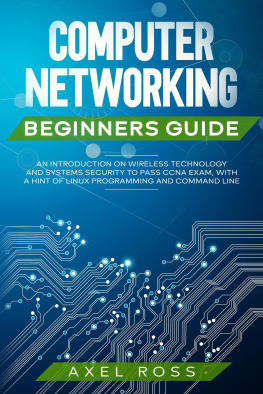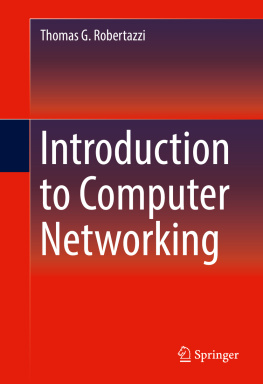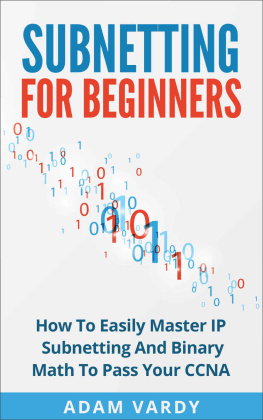COMPUTER NETWORKING FOR BEGINNERS
The Complete Guide to Network Systems, Wireless Technology, IP Subnetting, Including the Basics of Cybersecurity & the Internet of Things for Artificial Intelligence
Table of Contents
Introduction
Understanding the concept of computer is a potent endeavor to anyone who seeks to make good use of networking resources and services; in the current world where networking in all aspects of human interaction is heavily linked to the use of computers. From social networking through to digital media and business networking, the world has indeed become a global village thanks to the trillion-dollar idea of PC networking. In everything that we do, it is unavoidable to mention the Internet as the biggest fruit of PC networking. With a lot of strides having been made in computer networking, communication systems are becoming more and more efficient day in, day out.
In Computer Networking, readers get to familiarize themselves with the fundamental aspects of computer networking, starting with the very basic networking nitty-gritty that primarily aim at setting the tempo towards more advanced concepts of computer networking. Though briefly explained, the information provided for every topic is sufficiently covered to suffice the essential needs of a networking beginner.
The first chapter introduces the reader to the basic concepts of computers that include a simple description of a computer network, network topology, and network types. In addition, there is also a brief overview of wireless networks as well as a deep discussion of network security.
In subsequent chapters, other important networking topics come to the fore, including wireless technology, peer-to-peer networking, router, server basics, and IP addressing. Internet basics and functions are also covered with special attention on the World Wide Web. Furthermore, the book explores an overview of the CCNA course coverage as well as the essentials of machine learning.
The book introduces the reader to the exciting networking experience: it stirs up readers curiosity to venture further into the more advanced coverage of computer networking by offering a firm foundation in the larger field of PC networking.
Chapter 1: An Introduction to Computer Networking
Networking Essentials
What Is a Computer Network?
Computer network is a term that refers to any group of computers that are linked to one another, allowing for communication among them. A network also allows member computers to share applications, data, and other network resources (file servers, printers, and many others).
Computer networks may be differentiated according to size, functionality, and even location. However, size is the main criterion with which computer networks are classified. Thus, there are a number of unique computer networks that we shall discuss individually under the subtopic Types of Computer Networks.
Network Topologies
A network topology refers to the arrangement and the way components of a network are interconnected. There are two forms of computer network topologies.
Logical Topology
Logical topology defines how linked network devices appear in a network. It is the architectural design of a networks communication mechanism among the different devices.
Physical Topology
Physical topology can be said to be the way all the nodes of a network are geometrically represented. The following are the various types of physical topologies:
Bus Topology
In this topology, all hosts on a network are linked via a single cable. Network devices are either linked directly to the backbone cable or via drop cables.
When a node wants to relay some message, it relays it to the entire network. The message is received by all the network nodes regardless of whether it is addressed or not.
This topology is primarily adopted for 802.4 and 802.3 (Ethernet) standard networks.
Bus topology configuration is simpler in comparison with other topologies.
The backbone cable is a single lane through which messages are relayed to all the nodes on the network.
Bus topologies popularly rely on CSMA as the primary access method.
CSMA is a media access control that regulates data flow in order to maintain data integrity over the network.
Advantages of Bus Topology
The cost of installation is low since nodes are interconnected directly using cables without the need for a hub or switch.
Support for moderate data speeds by use of coaxial and twisted pair cables that allows up to 10 Mbps only.
Uses familiar technology that makes its installation and troubleshooting a walk in the park, since tools and materials are readily available.
There is a great degree of reliability since the failure of a single node does have no effect on the rest of the network nodes.
Disadvantages of Bus Topology
Cabling is quite extensive. This may make the process quite tedious.
Troubleshooting for cable failures is mostly a pain to most network administrators.
Chances of message collision are high in case different nodes send messages simultaneously.
The addition of new nodes slows down the entire network.
Expansion of the network causes attenuation-loss of signal strength. This may be corrected with the use of repeaters (to regenerate the signal).
Ring Topology
The only difference between ring topology and bus topology is that in the former, the ends are connected, while in the former, ends are open.
When one node gets a message from the sender, that node sends the message to the next node. Hence, communication takes place in one direction-it is unidirectional
Each and every single node on the network is linked to another node without a termination point. Data flows continuously in one loop-endless loop.
Data flow always takes a clockwise direction.
Ring topology often uses token passing as the main access method.
Token passing: an access method in which tokens are passed from station to another.
Token: a data frame that moves around the network.
Token Passing in Action
A token moves around the network from one node to another till the destination.
The sender puts an address plus data in the token.
The token passes from one node to the next-checking the token address against the individual addresses of each and every node on the network until it finds a match.
The token is used as a carrier-for data (and the destination address).
Merits of Ring Topology
Network management is relatively easy since faulty components can be removed without interfering with the others.
Most of the hardware and software requirements for this network topology are readily available.
The installation cost is quite low since the popular twisted pair cables that required in plenty are quite inexpensive.
The network is largely reliable since it does not rely on a single host machine.
Demerits of Ring Topology
Troubling may be quite a task in the absence of specialized test equipment. Detection of a fault in the cable is normally a serious challenge .
Failure in one node leads to failure in the entire network since tokens have to through each node for a complete cycle of communication from sender to destination.







